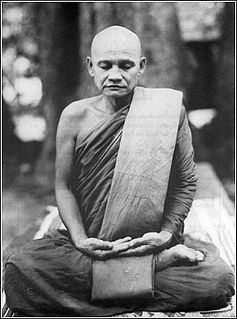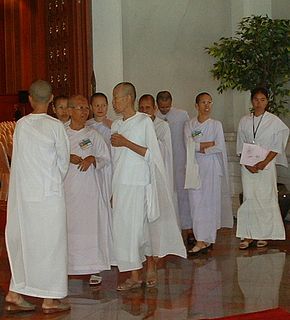| Part of a series on |
| Theravāda Buddhism |
|---|
 |
A siladhara is a Theravada Buddhist female monastic established by Ajahn Sumedho at Chithurst Buddhist Monastery, England. [1] In 1983, he obtained permission from the Sangha in Thailand, to give a ten-precept pabbajja to the women, making them officially recognized female renunciants trained in the Ajahn Chah lineage. The reasons for its establishment are due to the historical loss of the bhikkhuni (nun's) ordination in Theravada Buddhism, limiting renunciation for female Theravadins to ad-hoc roles such as the thilashins and maechis, neither of which garner respect from the Theravada community as genuine renunciates.

Theravāda is the most commonly accepted name of Buddhism's oldest extant school. The school's adherents, termed Theravādins, have preserved their version of the Gautama Buddha's teaching in the Pāli Canon. The Pāli Canon is the only complete Buddhist canon surviving in a classical Indian language, Pāli, which serves as the school's sacred language and lingua franca. For over a millennium, theravādins have endeavored to preserve the dhamma as recorded in their school's texts. In contrast to Mahāyāna and Vajrayāna, Theravāda tends to be conservative in matters of doctrine and monastic discipline.

Luang Por Sumedho or Ajahn Sumedho is one of the senior Western representatives of the Thai forest tradition of Theravada Buddhism. He was abbot of Amaravati Buddhist Monastery, UK, from its consecration in 1984 until his retirement in 2010. Luang Por means Venerable Father (หลวงพ่อ), an honorific and term of affection in keeping with Thai custom; ajahn means teacher. A bhikkhu since 1967, Sumedho is considered a seminal figure in the transmission of the Buddha's teachings to the West.

Cittaviveka, popularly known as Chithurst Buddhist Monastery, is a Theravada Buddhist Monastery in the Thai Forest Tradition. It is situated in West Sussex, England in the hamlet of Chithurst between Midhurst and Petersfield. It was established in 1979 in accordance with the aims of the English Sangha Trust, a charity founded in 1956 to support the ordination and training of Buddhist monks (bhikkhus) in the West. The current abbot, since 2014, is Ajahn Karuniko.














